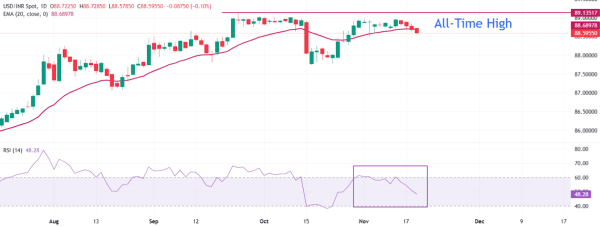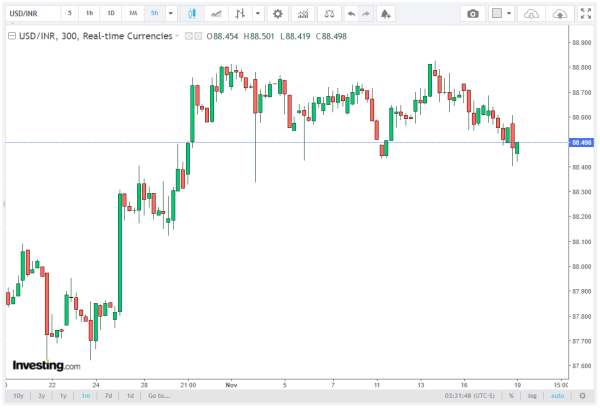The Indian Rupee (INR) continued its strong performance against the US Dollar (USD) for the fourth consecutive trading day on Wednesday. The USD/INR pair fell to near 88.60, as traders grew increasingly optimistic about a potential US-India trade deal.
The currency’s broad-based firmness reflects the growing expectations that a bilateral agreement could be announced soon, potentially reshaping trade flows between the two economies. The Orbisolyx finance team provides readers with a comprehensive and well-organized analysis of the matter.
US-India Trade Deal Hopes Boost INR
The recent surge in the Indian Rupee comes amid heightened optimism over a US-India trade pact. Market sentiment strengthened last week after the US President hinted at reducing tariffs on imports from India “at some point.” He further added that India had agreed to halt oil imports from Russia, signaling closer economic cooperation.
This week, trade optimism accelerated after India’s Commerce Secretary Rajesh Agarwal confirmed that the first part of the bilateral trade deal is “nearly closed.” The agreement reportedly addresses 50% tariffs and expands market access to the US. Agarwal also stated that the finalized deal will be announced on a mutually decided date, according to PTI reports.
India’s Commerce and Industry Minister Piyush Goyal reiterated that the deal would only be finalized when both sides are confident it is fair, equitable, and balanced. Speaking at the Indo-US Economic Summit, Goyal emphasized that when the deal meets these criteria, good news can be expected.
US Dollar Sideways Ahead of NFP Data
Despite the INR’s gains, the US Dollar (USD) remains under close observation ahead of key US economic data releases, particularly the Nonfarm Payrolls (NFP) report for September, scheduled for Thursday. At the time of writing, the US Dollar Index (DXY), which measures the Greenback against six major currencies, is trading calmly near 99.70, close to the weekly high.
Investors are watching the NFP data closely for clues on the Federal Reserve’s (Fed) monetary policy trajectory. The report will provide the first significant economic signal since the federal reopening, amidst concerns over labor market strength and AI-driven productivity changes.
The US NFP report is expected to show that 50K jobs were added in September, up from 22K in August, with the unemployment rate remaining at 4.3%. Average Hourly Earnings, a critical measure of wage growth, is forecasted to rise by 0.3% month-on-month and 3.7% year-on-year.

Currently, the CME FedWatch tool shows a 48.9% probability of a 25 basis point rate cut to 3.50%-3.75% in December, down from 66.9% last week. Traders have paired Fed dovish bets amid warnings of upside inflation risks from FOMC members, emphasizing caution on further monetary easing.
Meanwhile, the US President commented on the Fed Chair replacement, suggesting he has made his choice but did not disclose a name. He expressed a desire to replace Jerome Powell, highlighting potential uncertainty for US monetary policy.
Technical Analysis: USD/INR Extends Correction
From a technical standpoint, the USD/INR pair continues its correction, trading near 88.60. The pair is approaching the 20-day Exponential Moving Average (EMA) around 88.70, signaling a key support zone for short-term traders.
The 14-day RSI has dropped from the upper 60-80 range to the mid 40-60 zone, signaling that upward momentum is fading. This movement implies the pair may enter a consolidation phase before any trend continuation occurs.
Support and Resistance Levels: Immediate support is located at the August 21 low of 87.07, providing a potential floor for the pair. On the upside, resistance is seen at the all-time high of 89.12, which could act as a significant barrier if the pair attempts a recovery.
Traders should monitor volatility around these levels, particularly as the US NFP data and trade deal announcements could trigger sharp moves. A confirmed US-India trade agreement would likely reinforce INR strength, while stronger-than-expected US labor data could temporarily support the USD.

Market Outlook
The Indian Rupee is poised to extend its winning streak against the US Dollar amid positive trade expectations. A final US-India trade deal would improve bilateral trade flows, reduce tariff barriers, and bolster investor confidence.
At the same time, the US Dollar remains sensitive to labor market indicators and Fed policy expectations, with the upcoming NFP data acting as a potential market catalyst. Investors should closely watch the USD/INR technical levels, including the 20-day EMA, RSI trends, and key support/resistance zones, for actionable insights.
In conclusion, a combination of trade optimism, central bank policy outlook, and technical dynamics is likely to dictate the near-term direction of the USD/INR pair, making it a focal point for FX traders, portfolio managers, and emerging market analysts alike.







